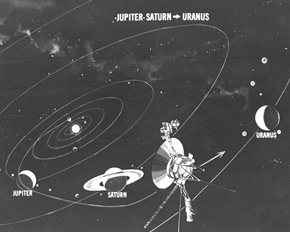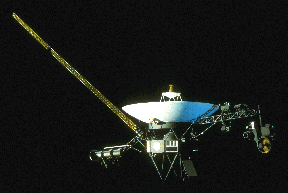Click on image for full size
Courtesy of NASA
Related links:
Voyager to Take the Lead!
News story originally written on February 16, 1998
At approximately 5:00 p.m. EST on February 17, 1998, the Voyager 1 spacecraft will become the spacecraft that has traveled farthest away from the Earth. For 25 years, Pioneer 10 has been in the lead in this race. When Voyager 1 becomes the most distant man-made object in space, it will be 6.5 billion kilometers from the Earth! It is nearing the edge of the solar system! Scientists are hoping that the spacecraft will reach the heliopause, where the Sun's influence stops. This would truly be where no spacecraft has gone before!
The Voyager spacecraft is expected to reach the heliopause by 2002.









